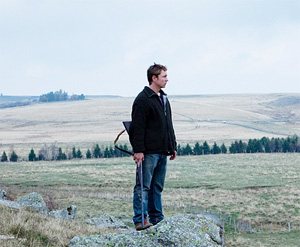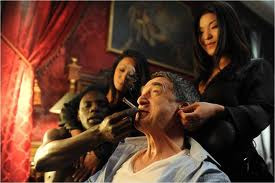
By Susan Gerhard, Glen Helfand, Lynn Rapoport, and Steven Beauregard
Film festivals are Rorschach tests, and the inkblot that is the San Francisco International might have produced, in its 55th edition, images of horror, laughter, nostalgia, cynicism, or hope, depending on the personality doing the viewing. But for all the varied tastes on tap, in the end, the festival produced some agreement. At last evening’s SFIFF Golden Gate Awards, prizes went to Nadav Lapid’s Policeman (New Director’s Prize), Goncalo Tocha’s It’s the Earth not the Moon (GGA Documentary Feature), and Peter Nicks’ The Waiting Room (Bay Area Documentary Feature). The festival closes tonight with a crowd-pleaser for the people: inviting the band Journey to the Castro stage for the Ramona Diaz (Imelda) doc about the rise of Filipino cover-act performer Arnel Pineda—equally adept at Robert Plant as he is at Freddie Mercury—to international stardom when he was called up to be the new lead singer for Journey, the spot once held by Steve Perry. What follows are thoughts from Keyframe writers on the live and sometimes bewildering experience of watching films, and in one case, a piece of art, in the rest of the festival. This collection is the second of two parts. For the first read “San Francisco International: The State We Are In.” [Editor’s update: Audience Awards, announced Thursday, May 3, went to Olivier Nakache and Eric Toledano’s The Intouchables (Best Narrative Feature) and Peter Nicks’ The Waiting Room (Documentary Feature).]
Aquarians Re-engaged with The Source
When the screening audience for a film about a 1970s Southern California cult, led by a heavily bearded health food restaurant proprietor turned alleged deity, is heavily peppered with former members of said cult—as well as other cults, communes, and uncategorizable experimental group-living arrangements—perhaps it shouldn’t be surprising when the post-film Q&A starts to unravel a bit around the edges, with audience members impassionedly talking over one another and unabashedly cutting off the responses of the filmmakers. Jodi Wille and Maria Demopoulos’s documentary The Source uses a rich arrangement of archival footage and present-day interviews to depict the rise and fall—the latter occurring with uncomfortable literality—of the Los Angeles–based Source Family. The cult grew out of Jim Baker’s legendary L.A. vegetarian restaurant the Source, many of whose employees and patrons followed Baker, or Father Yod, as he began to call himself, to a mansion in the Hollywood Hills formerly owned by the L.A. Times’ Chandler family. There they practiced an idiosyncratic blend of healthy living (minus the benefits of antibiotics and other Western medical interventions; plus mystically approached morning sessions of pot-smoking), adopted names like Galaxy the Aquarian and Magus the Aquarian, strove for a higher spiritual consciousness, and recorded albums that decades later would become collectors’ items among psych rock fans unfamiliar with the history behind them. During the Q&A, Wille admitted—perhaps somewhat infelicitously, in the city of Jim Jones—to having “drunk the Kool-Aid” while delving into the Source Family’s history. But her and Demopoulos’s film seems a fairly clear-eyed document of Father Yod’s trajectory from kindly spiritual/father figure into the dubious territory of exerting control over his followers’ sexual lives, making claims to a godly stature, and including underage girls among his collection of 13 wives. Viewers are left to digest and interpret these events, alongside images of euphoric lines of white-robe-clad Aquarians wading into the Pacific and clips from Annie Hall and SNL that gently abuse the fare and the philosophy served up at the Source. (Lynn Rapoport)
Sweating to the…Experimental Oldies in Pornographic Pursuit 2, from Human Moves, Animal Visions
Superfrog Gallery within the New People Building had viewers running at top speed, if not leaping like frogs while viewing Karolina Sobecka’s Pornographic Pursuit 2, the most engaging of the interactive pieces on display in the gallery (and brought here by Sean Uyehara of the San Francisco Film Society). While so much “interactivity” these days involves little more than pushing buttons near a flat rectangular screen, Sobecka’s piece a rich third dimension: It asks the viewer to run on a treadmill at an increasing pace in order to be rewarded with an image of a woman who may or may not be Marilyn Monroe disrobing (clipped from Bruce Conner’s Marilyn Times Five) while toying with, at various points, a Coke bottle and an apple. In the Garden of Eden, pre-snake, we imagine a similar innocence to the pursuit of pleasure; in these end times, one becomes the spectacle itself as viewers enter the gallery and see the ungainly voyeur attempting, and failing, to create an act of enjoyment. Neuroscience, and theories popularized by Antonio Damasio about how emotions drive decision-making, have woven themselves into discussions of Sobecka’s work. But don’t let the conversation around state-of-the-art TED-talking science dissuade you from experiencing the thrill of it yourself should you get the chance: It is, truly, entertainment. Sweat may pour, not just from miles logged, but from shame and anxiety of the process itself. (Susan Gerhard)
The Art of Reinvention via The Love Song of R. Buckminster Fuller
Inventor and idealist R. Buckminster Fuller, the subject of an exhibit at San Francisco Museum of Art (The Utopian Impulse: Buckminster Fuller and the Bay Area), did not, director-performer Sam Green told a live audience, speak in 30-second sound bites. He spoke in long, drawn-out sentences, for hours at a time, and in one case, 42 hours—allegedly using his pant leg as a urinal if he was caught up in the “flow” of ideas—which made him difficult to distill for a short, one-hour documentary. But the craft of distillation is one Green has mastered (Green had access to the entire Samuel Pepys-level archive of Fuller’s incredibly self-documented life). The “Bucky” brew he presented in his live-documentary format, which includes Powerpoint style start-stops and enriching accompaniment from, in this case, live band Yo La Tengo, mixed fact-based optimism and artful ironies to create a potent picture of a serial re-inventor who picked himself up after multiple tragedies, including the death of a child, an ill-timed accident involving his Dymaxion car, and an up-in-flames geodesic dome built for Expo ’67 in Montreal. It was a mesmerizing take on the inspired dreamer who first sparked Stewart Brand and countless other “outside-the-box” pragmatic idealists; Yo La Tengo’s inspired, punctuating percussion and dreamy through lines cast a spell …which was, sadly, broken by the audience itself in the literalizing Q&A after the film ended. (SG)
Double Takes: Found Memories and The Exchange
In her introduction to the May 1 screening of the Brazilian film Found Memories, Rachel Rosen noted that the original title, when translated from Portuguese, is Stories That Only Exist When Remembered. It is a far more instructive title for the first narrative feature by Júlia Murat. She wrings poetics from a familiar plotline: Calcifying elders who live in a tiny town where the trains no longer stop,and no one seems under retirement age are faced with change. Their lives are ritualistically regimented by church, meals, and various other actions. The protagonist is a dour old woman who rises before dawn to bake bread for a local café owner, with whom she has a daily scuffle and nearly verbatim arguments. She spends every night writing letters to her long deceased husband, placing them in par avion envelopes which accrue in a dented hatbox. Into this world stumbles a young female photographer in search of some kind of escape. As is the case with stories like this, youth shakes up the routine, interrupting the rhythm in poignantly unhurried ways.
Murat’s in no hurry to get anywhere, and the film has a gentle grace—her camera lingers on faces, poetically worn surfaces, and fading photographs. You know where this is going, but the road is both picturesque and emotionally moving, and surprising in subtle ways. It served as a more satisfying counterpoint to a similar scenario in Israeli director Eran Kolirin’s The Exchange, his slightly surrealistic follow up to The Band’s Visit. His new film also tracks a regimented life, a dazed science professor whose comfortable routine is shaken one afternoon when he goes home early and has something akin to an out-of-body experience. His quirky sense of heightened awareness (or is it regressive childlike awe?) involves deadpan, sometimes obnoxious actions and detached observation. Like Memories, it has a relaxed pace and narrative twists, but a reduced payoff. It’s a story that doesn’t “exist” in our minds for quite as long. (Glen Helfand)
A Michelin May Day: Step Up to the Plate
There turned out to be some local irony to the fact that the added screening of SFIFF’s French foodie favorite, Step Up to the Plate, would be scheduled on May Day, immediately following some unfortunate Occupy-attributed ransacking of chic eateries in San Francisco’s Mission District the night before. Programmer Rod Armstrong still asked who had dinner reservations following. Paul Lacoste’s calm doc, concerning a noted French culinary clan’s generational changing of the guards in their renowned restaurant, may have food porn appeal, but it is also a meditation on family and mortality. The antithesis of Iron Chef’s race against the clock competitive spectacle, Plate focuses on creative challenges, congenital dispositions, and conflict between father and son, Michel and Sebastien Bras. Theirs is a dynamic of gently simmering resentments between men of few words, and complicated feelings are captured on their impassive faces. Their signature dishes, the result of artistic temperament, are colorfully captured, from sketch to plates painted with smears of reductions. Their craft veers on the fussy Michelin-star continuum, but in the end, the Bras father and son are people you not so much root for but observe with engaged empathy in this satisfying cinematic meal. (GH)
A woman lingered outside ‘People Mountain People Sea,’ agitated and in need of unpacking this unsettling, somewhat cryptic film. Cai Shangjun’s wonderfully composed shots, as if a Chinese update of Antonioni’s ‘Red Desert’, often drop the viewer into already unfolding scenarios, only gradually revealing who we’re following and their place in this grimy, somewhat anthropological story. The tone is unrelentingly downbeat—the arc is a nearly literal descent into hell—yet the director maintains the power of keeping the viewer connected to this unsavory vision. I countered that this was one of those moments that film festivals are made for.
Bewildered, Beguiled? People Mountain People Sea
Following the April 25th screening of Cai Shangjun’s searing tale of revenge in working-class China, a woman lingered outside, agitated and in need of unpacking this unsettling, somewhat cryptic film. I wasn’t the first person she queried about What is Was We Just Saw. “I don’t understand what happened,” she pleaded, with some resentment. There were indeed some narrative loose ends to this tale of a theft, senseless killing, drug addiction, rape, corruption and backbreaking menial labor set against a backdrop of urban and rural poverty, but it probably was a good thing that there wasn’t a Q&A afterward. Leaving things somewhat upturned is part of Cai’s strategy. His wonderfully composed shots, as if a Chinese update of Antonioni’s Red Desert, often drop the viewer into already unfolding scenarios, only gradually revealing who we’re following and their place in this grimy, somewhat anthropological story. It centers around an unlikable, and somewhat inexpressive lead actor, who keeps us engaged with a visage capable of classic Clint Eastwood stoicism. The tone is unrelentingly downbeat—the arc is a nearly literal descent into hell—yet the director maintains the power of keeping the viewer connected to this unsavory vision. If that woman was agitated, I countered that this was one of those moments that film festivals are made for—discovery and dialogue. (GH)
Landscapes: Last Winter
“I won’t change the way I work,” insists Johann, the brooding hero at the center of John Shank’s melancholic drama Last Winter, set in the rolling pastures of the French countryside. Though he’s the youngest among them, Johann has assumed the position of leader of a struggling agricultural co-operative comprised of tight-lipped farmers with creased brows and grody fingernails. Faced with debilitating financial hardships and the prospect of another harsh, unforgiving winter on the horizon, Johann tries to maintain a brave face despite mounting dissent and a nagging fear of the inevitable.
The possibility of reprieve comes when a local businessman offers to purchase the farmer’s calves, rather than wait until they have reached maturity, which would in effect spell the end of the traditional rearing work that the co-op has performed for generations. Rallying the farmers behind him, Johann resists selling out—but how long can he last? Further tragedy strikes in the form of a barn fire and, to make matters worse, Johann’s mentally unstable sister moves back in with him and his girlfriend. Johann just can’t seem to catch a break. Much like other similarly themed films that depict the changing way of life in agricultural communities (documentaries Sleep Furiously and Sweetgrass spring to mind), Shank uses ample screen time to honor the landscape and the physical labor required to farm it the honest way. While protecting traditions in the face of modern economic challenges is a major theme of Last Winter, this film is really about a man who is determined to stay in control of his own destiny. “It will all be OK,” Johann reassures those around him, but mostly for his own benefit. “It will all be OK.” (Steven Beauregard)
Centerpiece High Point with Your Sister’s Sister
Selected for SFIFF’s midpoint-marking Centerpiece screening, Lynn Shelton’s Your Sister’s Sister, her follow-up to festival favorite Humpday, sees the director working in the familiar terrain of awkward sexual experimentation. Since coming on the scene three years ago with Humpday (the film won the Dramatic Special Jury Grand Prize at Sundance that year), Shelton has busied herself in TV, directing episodes of the hit series Mad Men and New Girl. This return to feature filmmaking is a charming story marked by strong comedic performances and likable but flawed characters.
After the death of his brother, Jack (Mark Duplass) treks out to a cabin owned by the family of his best friend (and his brother’s ex) Iris (Emily Blunt) to do some soul searching. Expecting some alone time in the wilderness, Jack is surprised to find Iris’ sister Hannah (Rosemarie DeWitt) holed up in the cabin, licking her wounds after a bad break-up. After commiserating over a bottle of Tequila, the two emotionally damaged exiles engage in some recreational activities that lead to unforeseen consequences when Iris unexpectedly shows up the following day.
Although Your Sister’s Sister is largely improvised, Shelton deserves much praise for getting the best from her performers. Blunt and DeWitt (who was present at the screening and stayed for a Q&A afterward) are more than game for raunchy repartee and deliver convincing turns as loving half-sisters both at a crossroads in their lives. But it’s Duplass who is the standout. Making a name for himself as co-director (along with his brother) of recent mainstream fair Cyrus and Jeff Who Lives at Home, Duplass’s turn as the down-in-the-dumps Jack is a breakout for the actor. Playfully improvising has way through scene after scene, Duplass has perfect the frazzled, grasping-at-straws-quality that has propelled actors like Vince Vaughn and Luke Wilson to stardom.
Set largely in a rural cabin and with a cast predominantly limited to the three leads, Your Sister’s Sister is a small film in one sense. And yet, it has potential to be a crossover success beyond the festival circuit and small independent movie houses. The film delivers more legitimate laughs than a majority of the commercial romantic dramedies in recent memory, and possesses exponentially more heart. IFC picked up the rights at the Toronto Film Festival in September and plans to release it in late June. (SB)
Girls on Film: Lola Versus
Daryl Wein’s relationship comedy Lola Versus opens with the titular character (the ubiquitous Greta Gerwig) waxing philosophical, twirling on the beach on the eve of her 29th birthday. Change seems to be in the air, much to the displeasure of the blessed Lola: “What if I like my life exactly how it is?” she asks. I don’t blame her; everything seems to be working for the bubbly, gluten-free Lola, having just been proposed to by her hunky, artist boyfriend Luke (Swedish import Joel Kinnaman). But when Luke abruptly calls off the engagement, Lola’s life is sent into a tailspin resulting in a series of impulsive, self-destructive decisions paraded for our enjoyment.
Featuring off-the-cuff banter last heard on the late-WB series Gilmore Girls, Hamish Linklater’s Henry asks “What’s your thread count?” before agreeing to jump into bed with Lola, while the overbearing Alice (a maniacally off kilter Zoe Lister Jones, who also co-wrote the script with Wein) exclaims, “Who puts your sentences together? Your brain is like a bad DJ!” Lola Versus delivers in spades the type of quirky dialogue you would expect from an indie starring Gerwig. Lola and her cohort of friends speak honestly and quickly, over-sharing even when it’s far from necessary. In fact, much of the film is delivered at a rapid pace, including a montage of sleepless nights and yoga classes meant to convey Lola’s newfound enlightenment.
With the new HBO series Girls receiving much attention on the interwebs and beyond, it seems the romantic travails of intelligent, privileged young women are having a moment (read Margaret Talbot’s New Yorker piece for more on this). But why the backlash? What’s all the fuss about? Well, for starters, the characters in Lola Versus say things like, “Remember the time we did mushrooms at your parent’s country house?” without a tinge of irony. The New York of Lola Versus is not populated by the types of people with real-world problems or relatable pressures—for someone writing her dissertation, you never see Lola do a lick of work (what school does she go to, exactly?) She busies herself bed hopping, throwing parties and going out drinking with gal-pal Alice. I’s a relief when, at the film’s conclusion, Lola realizes that what she needs is alone time. (SB)






